After Russia’s illegal full-scale invasion of Ukraine in February 2022, Western partners imposed unprecedented financial sanctions and export controls against Russia. These measures aim to achieve three objectives:
1. Significantly reduce Russia’s revenues from commodities exports;
2. Cripple Russia’s military capability and ability to pursue its war;
3. Impose significant pain on the Russian economy.
The Atlantic Council’s Russia Sanctions Database tracks the restrictive economic measures Western allies have placed on Russia and evaluates whether these measures are successful in achieving the stated objectives and bringing lasting peace to Ukraine. The Database is now static and was last updated in November 2024. You can access the final version here.
Key takeaways:
- Russia’s oil and gas revenue dropped by 22 percent in the first eleven months of 2025. After sanctions hit Lukoil and Rosneft, Moscow is scrambling to reroute oil exports through smaller companies.
- Despite export controls, Russia’s military industrial base continues to expand. Moscow claims to have localized nearly 90 percent of drone manufacturing and assembly.
- Russia’s federal deficit continues to expand, and corporate debt has surged by 71 percent since 2022. To raise revenue in the face of a declining economy, the Kremlin has increased taxation and issued $2.8 billion worth of yuan-denominated bonds.
In October, the United States targeted two of Russia’s largest oil majors, Rosneft and Lukoil, along with their subsidiaries, with primary sanctions that carry secondary sanctions risks. While significant, this action represents the only sanctions the Trump administration has so far issued in 2025 against Russia in response to its ongoing war in Ukraine. Western partners, including the European Union (EU) and United Kingdom, have issued multiple sanctions packages to pressure Russia to end the war. At the same time, the United States has held multiple rounds of peace talks with Russian counterparts, none of which has produced clear results.
Acceptance of any cease-fire would force Russian President Vladimir Putin to lift the mobilization decree that has been in place from 2022, a move fraught with political, economic, and military costs for the Kremlin. It would also contradict the Kremlin’s pursuit of effective political control over Ukraine and its conviction that Kyiv can be compelled to capitulate by force. Therefore, Russia is stalling while seeking sanctions relief and territorial gains, and promising lucrative business opportunities. As negotiations continue, US policymakers and their Western allies should remain clear-eyed about Russia’s aims, as well as the true state of its wartime economy. Maintaining firm economic pressure now through sanctions and export control enforcement may force Moscow out of its stall tactics and compel Putin to agree to a peace deal to save Russia’s declining economy, ultimately achieving Group of Seven (G7) sanctions objectives.
Overview
- Objective 1: Significantly reduce Russia’s revenues from commodities exports
- Objective 2: Reduce Russia’s ability to wage the war
- Objective 3: Impose significant pain on the Russian economy
- Conclusion and policy recommendations
Objective 1: Significantly reduce Russia’s revenues from commodities exports
Russia scrambles to reroute oil exports as sanctions hit Lukoil and Rosneft
Russia’s commodity revenues have been hit hard this year by a combination of low global oil prices, a stronger ruble, Ukrainian drone strikes on Russia’s energy infrastructure, and sanctions by the United States, EU, and United Kingdom. From January to November, Russia’s oil and gas revenues totaled an estimated $102 billion—a 22 percent drop from 2024. US and UK sanctions on Lukoil and Rosneft added further pressure, pushing Russian oil prices downward and leaving millions of barrels stranded at sea with no buyers. At the same time, Lukoil has been forced to seek buyers for its foreign assets and equity holdings in other energy firms. Rosneft, which has reported a 70 percent decline in profits in the first nine months of 2025, has not announced any actions in response to sanctions.
China and India, which had continued to import the majority of Russian oil despite sanctions and the oil price cap, now face the risk of US secondary sanctions if they continue to import oil from Russia’s four oil majors—Rosneft, Lukoil, Gazprom Neft, and Surgutneftegas. (The latter two were designated by the Biden administration in January.) In response, Russia has rerouted oil exports through smaller Russian companies such as Tatneft, Rusexport, Morexport, and Alghaf Marine to circumvent sanctions and reduce their trading partners’ exposure to US secondary sanctions. Moscow is likely to continue using intermediaries and third-party trading entities, reshuffling ownership of these companies, and other sanctions evasion techniques to isolate sanctioned entities from potential buyers.
Russia’s quick reaction to sanctions by shifting oil exports to smaller companies indicates that the sanctions against oil majors were effective. Russia is scrambling to reroute oil exports and reduce its trading partners’ sanctions exposure risk because it relies on revenue from oil sales. Sanctioning the oil is proving to be an effective strategy and pressure point that the United States and its partners should continue to enforce and pursue. This approach forces Russia to remove major companies from the market, restructure ownership of its companies, and create multiple layers for sales, which is expensive and further reduces its oil revenues. Maintaining this strategy is crucial to sustain economic pressure on Russia.
Russia uses cryptocurrencies for foreign trade
Restricting Russia’s access to foreign currency and ability to conduct cross-border transactions has been a key component of efforts to limit its revenue from commodity exports. Cut off from the US dollar and other major currencies, Russia has increasingly conducted trade with China in renminbi and with India in rupees. More recently, Moscow eased restrictions on cryptocurrencies, allowing the use of Bitcoin and other digital assets for cross-border transactions, including for oil payments from India and China. Chinese and Indian buyers usually pay for oil in yuan or rupees, depositing the funds into an offshore account controlled by a middleman. The middleman converts the money into cryptocurrency and sends it to a Russian account, where it is exchanged for rubles. Crypto payments currently might be playing a limited role in Russia’s oil trade, but their strategic implications are substantial. By operating beyond Western oversight, they risk becoming a much larger sanctions evasion challenge if left unchecked by the United States and its partners.
Recognizing the growing role of digital assets in Russia’s economy, some senior Russian officials—including Maxim Oreshkin, deputy chief of staff to Putin—have argued that cryptocurrency mining should be treated as an export industry. Oreshkin has noted that Russia’s crypto-related financial flows are significant but largely absent from official economic statistics. He has proposed that these flows be incorporated into Russia’s balance of payments reporting, which would alter the way Russia’s economic performance is measured and legitimize cryptocurrency within the country’s financial infrastructure.
Beyond mainstream cryptocurrencies like Bitcoin, Russia has embraced A7A5, a ruble-backed stablecoin that has rapidly become central to its cross-border payments. By mid-2025, blockchain-analysis firms reported that A7A5 was moving close to one billion dollars per day, with cumulative transfers exceeding forty billion dollars. Shortly afterwards, the EU’s nineteenth sanctions package banned all transactions involving A7A5 and sanctioned the issuer and related exchanges. The United States and the United Kingdom have also sanctioned companies tied to the token.
Given A7A5’s rapid growth and its potential use in sanctions evasion, US and allied authorities will need to strengthen oversight of stablecoin infrastructure and work with issuers and exchanges to prevent sanctioned Russian actors from converting ruble-linked tokens into internationally usable digital assets and fiat currencies.
Russia remains dependent on the shadow fleet
The shadow fleet continues to play a central role in exporting Russian oil and liquefied natural gas (LNG). Currently, the global shadow fleet consists of 3,240 aging vessels, representing about 17 percent of global oil tankers, used by Russia as well as other heavily sanctioned countries to bypass sanctions and the G7 oil price cap. The shadow fleet uses deceptive shipping practices including shell companies, flag-hopping, ship-to-ship (STS) transfers, and automatic identification system (AIS) manipulation to transport seaborne energy commodities. Notably, 113 vessels flying a false flag transported €4.7 billion (approximately $5.4 billion) worth of Russian oil in the first three quarters of 2025. This year, those evasion practices have only become more entrenched. In October alone, Russia exported 44 percent of its oil through shadow fleet tankers.
Gaps in designations of tankers among the UK, EU, and US jurisdictions have undermined overall effectiveness of shadow fleet sanctions. Notably, enforcement leadership shifted toward Europe and Canada this year, which expanded vessel designations and advanced joint monitoring efforts, including a shadow fleet task force. The United States designated far fewer tankers this year, creating gaps between US, EU, and UK sanctions that Russia and other countries are exploiting. Meanwhile, China is beginning to assemble its own shadow fleet to import sanctioned Russian LNG. This new fleet is adopting the same tactics as Russia, obfuscating ship ownership, AIS-spoofing, and STS transfer practices. Coordinated action among allies is essential to close these enforcement gaps and prevent further exploitation of the international oil trade.
To further restrict Russia’s energy revenue, US policymakers should align and enforce shadow fleet sanctions with the EU and United Kingdom. Effective sanctions enforcement includes sharing information with the private sector on shadow fleet activity and implementing standards for flagging states to hold flag registries accountable when they work with sanctioned vessels. Additionally, the United States and its allies should collaborate to address China’s growing role in transporting and refining Russian-originated oil and LNG. These steps, as reflected in the SHADOW Fleet Sanctions Act of 2025 (S.2904), which was introduced this fall in the Senate, aim to close enforcement gaps enabling Russia’s shadow fleet revenue.
Objective 2: Reduce Russia’s ability to wage the war
Russia’s military industrial base is thriving
Western export controls on dual-use technologies have not prevented the growth of Russia’s defense sector. The country’s military-industrial base has continued to scale up, fueled largely by wartime domestic demand. In 2024, Russia’s two leading arms producers—Rostec and the United Shipbuilding Corporation—reported a combined 23 percent increase in arms revenues, reaching $31.2 billion, even as both firms remained under Western sanctions. That same year, Russia significantly expanded weapons production, manufacturing 1.3 million 152-millimeter artillery shells—more than four times its 2022 output—and approximately 700 Iskander short-range ballistic missiles.
Yet Russia still relies on key foreign inputs to keep its production lines running. Iskander missiles, for example, require significant quantities of sodium chlorate, a chemical Russia cannot yet produce at scale. Although Moscow is building new facilities, they will not come online until between 2026 and 2027. In the interim, China supplied 61 percent of Russia’s sodium chlorate imports while Uzbekistan provided 39 percent in 2024.
Russia’s rapid expansion of its drone arsenal is similarly thanks to foreign partners. Tehran has provided the cheap, long-range Shahed drone systems that have enabled Russia to dominate Ukrainian airspace. A $1.75 billion deal signed in 2023 gave Russia access to thousands of drones and substantial support for establishing domestic production lines—paid for in part with several tons of gold ingots. Russia now claims to have localized roughly 90 percent of its drone manufacturing and assembly. Output reportedly doubled from fifteen thousand long-range drones in 2024 to more than thirty thousand in 2025, alongside up to two million small tactical drones.
China remains a critical supplier of rare metals—including gallium, germanium, and antimony—essential for drone and missile production. However, this has come at a cost, with Beijing nearly doubling prices on sensitive exports to Russia’s defense sector since 2021. China has also deepened its investment role, recently acquiring a 5 percent stake in a leading Russian drone manufacturer, underscoring growing integration between the two countries’ defense industries.
Despite this progress, Russia’s weapons systems still rely on some Western components, such as advanced sensors and microcomputers for flight control systems. Ukraine recently reported that more than 100,000 foreign-made parts were recovered from 550 Russian drones and missiles that struck Ukrainian territory during a large-scale bombardment. These components continue to flow into Russia through extensive networks of intermediaries and shell companies, largely based in China, Turkey, and the United Arab Emirates—highlighting that Western export controls have fallen short of significantly constraining Russia’s ability to wage war.
Russia is experiencing significant labor shortages
Even as Russia scales up arms production, it faces acute labor shortages that threaten its ability to sustain the war. An aging and shrinking population has been further depleted by the loss of hundreds of thousands of young men on the front lines. Under pressure from the Kremlin, regional governments have built a quasi-commercial recruitment system in which freelance headhunters earn commissions for delivering new soldiers. This strategy has involved offering generous signing bonuses and payments for wounded soldiers and for the families of those killed in action. While these incentives have boosted recruitment, they still fail to generate sufficient volunteers, and these numbers are likely to continue to drop with recent reports suggesting that benefits are being significantly delayed and that signing bonuses are dropping rapidly as regional budgets come under increasing strain.
To fill the ranks, the Kremlin has relied heavily on mercenaries. Migrants and foreign students inside Russia have been coerced into military service under threat of visa cancellation. Moscow has also recruited fighters from adversarial actors such as the Houthi rebels and North Korea, and it has conducted deceptive global recruitment campaigns that lure men from a vast array of countries with promises of high-paying jobs or training programs—only for them to be handed over to Russian mercenary groups upon arrival. These foreign fighters, often deployed in risky offensive maneuvers to shield more highly trained Russian units, suffer especially heavy casualties. According to Ukraine, Russia has recruited at least eighteen thousand fighters from 128 countries.
To address labor gaps in the defense industry, Russia has also recruited foreign civilian workers through programs like “Alabuga Start.” Alabuga—a major industrial complex in Tatarstan—has become the central nerve of Russia’s mass drone production. The program targets young women, particularly from African countries, with offers of well-paid jobs in cafes or stores. In reality, recruits are forced to work under hazardous conditions, handling toxic materials without protective gear and living under constant surveillance. Working at Alabuga also means direct exposure to the war, as Ukraine drones frequently target these factories.
Russia’s growing dependence on foreign mercenaries and laborers has not gone unnoticed. Botswana’s Interpol branch has opened investigations into potential human-trafficking links to Alabuga Start. South African authorities have initiated legal action against individuals involved in facilitating deceptive recruitment. Nepal has banned its citizens from seeking employment in Russia. While many countries have urged Moscow to stop illegally recruiting their citizens, without coordinated international action these recruitment pipelines are unlikely to cease.
Objective 3: Impose significant pain on the Russian economy
Russia’s economy is in decline
Given the growing limitations and unreliability of official data from Moscow, it is difficult to assess the state of the Russian economy with certainty. However, when interpreting Russian data alongside independent sources and anecdotal evidence, a number of indicators arise suggesting that after nearly four years of war and isolation from the global financial system, it is becoming increasingly difficult for Russia to make ends meet.
Following the recent implementation of US sanctions on Russian oil majors, the International Monetary Fund downgraded Russia’s 2025 growth forecast from an already weak 0.9 percent to 0.6 percent, continuing a downward trend seen in 2024. Despite the decline in growth and high interest rates, inflation remains stubbornly high at 6.6 percent—well above target and widely believed to be understated. Nevertheless, the Russian Central Bank has lowered interest rates from 21 percent in May to 16.5 percent in October, likely in an effort to stimulate growth.
Russia’s budget plan estimated an increase of the deficit from 1.7 percent of gross domestic product (GDP) in 2024 to 2.6 percent in 2025 (approximately $72 billion, based on Russian GDP reporting), while the cost of debt servicing is predicted to rise to 8.8 percent of total budget expenses. In the past the National Welfare Fund played a major role in paying the bills, and while the Ministry of Finance reports the fund’s total value at 6.1 percent of GDP (approximately $169.5 billion), its liquid assets—the portion that can actually be used to finance the deficit—have dwindled to roughly 1.9 percent of GDP (about $51.6 billion).
The most significant source of revenue remains oil and gas sales, which—despite declines due to lower global prices, a stronger ruble, and Ukrainian strikes on refineries—still account for an estimated 30 percent of federal income. This contribution is expected to shrink substantially due to the newly imposed sanctions on Lukoil and Rosneft. It is important to note that this will likely result in a deepening deficit as the budget plan did not factor in the possibility of escalating sanctions or tougher enforcement.
Signs are already emerging that Moscow is struggling to cover its growing deficit in the wake of these new sanctions. Reports indicate that payments to wounded soldiers and families of those killed in action have been significantly delayed and reduced, while signing bonuses for new recruits—which once reached as high as fifty thousand dollars—have declined sharply. Nevertheless, these costs are likely to remain substantial, as the government relies on this quasi-commercial recruitment system to maintain troop levels at the front lines. These benefits have also played a key role in dampening any public dissent toward the war.
Russia turned to taxation and loans to fund its war economy
With other sources of revenue becoming depleted, Russia has turned to increasing taxation to raise revenue. In 2025, the Russian government increased the income tax (while deductions for low-income families were reduced), the value added tax from 20 percent to 22 percent (with lower thresholds for small and medium-sized enterprises to avoid the tax), the profit tax from 20 percent to 25 percent, the profit tax on oil transport to 40 percent, and mineral extraction taxes on iron, coal, and gold. To cushion households, Moscow announced a 20.7 percent increase in the minimum wage effective in 2026. However, this measure is likely to raise government spending and will not fully offset the heavier tax burden—particularly for urban households earning above minimum wage. At the same time, higher taxes and wage floors will further strain Russian industry, which has already been under significant pressure, with non-military sectors contracting 5.4 percent since January and furloughing workers to cut costs.
In addition to revenue, Russia has also relied on loans to fund its war economy. In December, Moscow issued $2.8 billion worth of yuan-denominated bonds, a move that reflects growing pressure to finance its fiscal deficit as military expenditures remain high and oil revenues fall. Although this issuance cannot offset Russia’s exclusion from Western financial markets, it marks a notable precedent that could open a new funding channel for more frequent use in the future. It also highlights a shift on China’s part, with Beijing having been hesitant only months earlier to allow Russian entities to issue yuan bonds due to concerns over secondary sanctions.
However, given the limited options for external financing throughout the war, much of the burden has fallen onto major Russian banks. These institutions have increasingly extended preferential, state-directed loans to companies involved in the war effort. These loans carry low interest rates far below the rate set by the Central Bank and are not recorded as federal expenditures, suggesting that the state of the economy is likely worse than the current deficit suggests. Since 2022, corporate debt has surged by 71 percent, reaching roughly $446 billion. This rapid expansion has become a key driver of inflation and limits the central bank’s ability to curb price growth through rate hikes. It also creates mounting systemic risk by burdening banks with a growing portfolio of high-risk, state-mandated loans.
Signs of stress have already started emerging. One of the clearest examples is Russian Railways—Russia’s largest commercial employer and a pivotal link in the country’s logistics and industrial and energy supply chains—which has accumulated roughly $51 billion in debt. The Kremlin has intervened to stabilize the company, with VTB, Russia’s second-largest bank, agreeing to restructure its debt. At the same time, the central bank is being pressed to extend a 2025 measure that allows banks to restructure corporate loans without a corresponding increase in their reserves. This effectively compels banks to absorb more risk in order to keep strategic enterprises afloat, underscoring both the fragility of Russia’s wartime credit system and the limits of its financial insulation.
Conclusion and policy recommendations
After three years of increasing economic pressure on Russia in response to its brutal war in Ukraine, sanctions are achieving the G7’s stated objectives. Russia’s economy is in decline, and sustaining economic pressure may create the conditions to compel Putin to end the war on terms favorable to Ukraine. To achieve this, the United States and its partners should consider the following policy recommendations:
- The US Treasury should continue pressure on Russia’s energy sector and sanction smaller Russian oil companies and foreign entities transacting with them, leveraging secondary sanctions authorities.
- The G7 should move forward with a proposed ban on maritime services for Russia.
- Western partners should leverage mechanisms such as the United Nations International Maritime Organization to develop new tools and expand interpretations of existing maritime law to confront Russia’s shadow fleet and the threat the fleet poses to maritime infrastructure.
- Congress should take a lead on the shadow fleet issue and adopt the Shadow Fleet Act.
- The US Treasury, in coordination with the EU and UK sanctions authorities, should work with stablecoin issuers and exchanges to ensure the ruble-backed stablecoin A7A5 is not exchangeable with dollar-backed stablecoins or other fiat currency-backed coins.
- The United States and its partners should map out how Russia, Iran, North Korea, and Venezuela are working together or sharing tactics and techniques to export sanctioned oil and import sanctioned goods, recognizing the similarities in how these countries operate. Mapping out these activities may help identify vulnerabilities within these networks and opportunities for disruption. Further, the United States and its partners should take a network approach to enforcing sanctions on Russia, Iran, North Korea, and Venezuela and leverage secondary sanctions in order to disrupt and deter sanctions evasion.
- The United States should align sanctions with Western partners to maximize effect and streamline enforcement and compliance.
- Western partners should consider providing legal assistance and investigative support to countries from which Russia is recruiting laborers to raise awareness of the issue, strengthen their law enforcement investigations into Russian recruitment networks, and where applicable, pursue legal action to hold perpetrators accountable. Further, the United States, United Kingdom, EU, and other like-minded partners should use their authorities to impose sanctions on individuals and entities involved in facilitating these recruitment efforts as they support Russia’s harmful foreign activities.
- The United States should continue to engage with China on export controls enforcement as it relates to Russia and seek committments from Beijing to ensure sensitive Western technologies such as H200 semiconductors are not sold or reexported to Russia.
Authors: Kimberly Donovan, Maia Nikoladze, Lize de Kruijf, and Mary Kate Adami
Past editions
Related content
Join our list
Sign up for other events and analysis from the GeoEconomics Center.
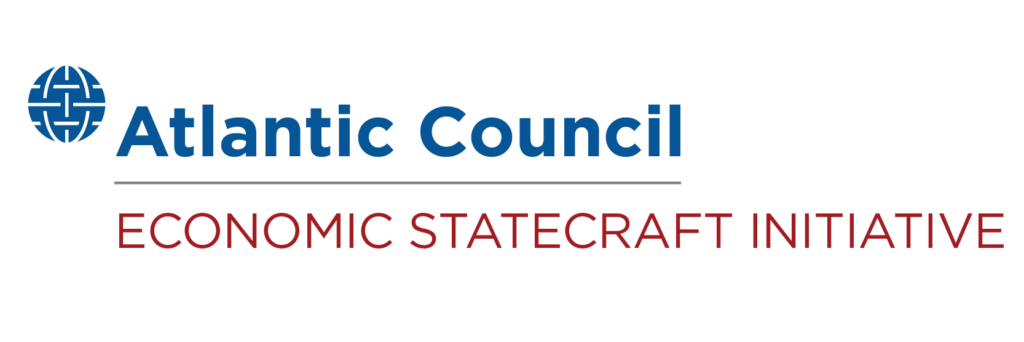
Economic Statecraft Initiative
Housed within the GeoEconomics Center, the Economic Statecraft Initiative (ESI) publishes leading-edge research and analysis on sanctions and the use of economic power to achieve foreign policy objectives and protect national security interests.

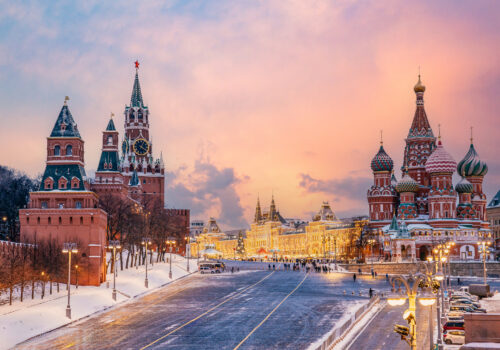
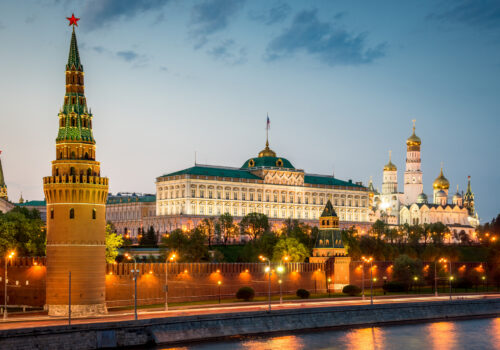
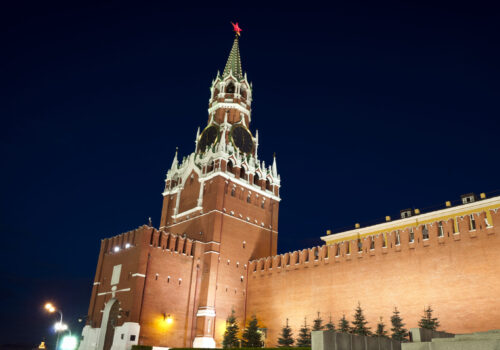
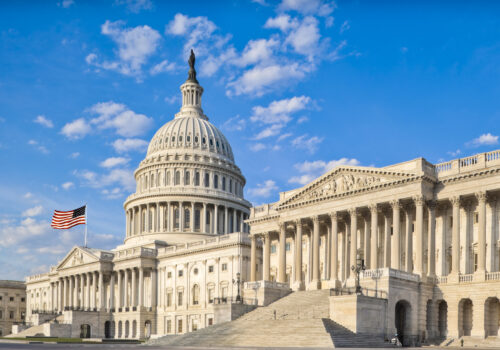
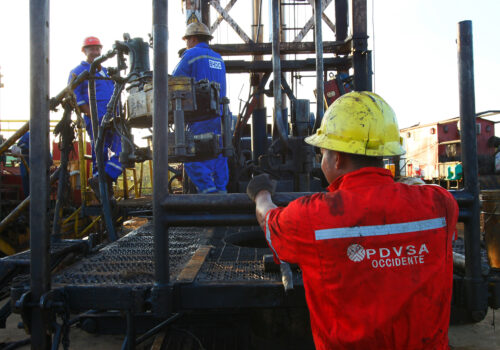
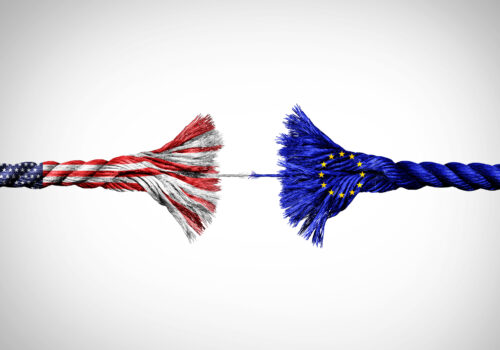
Follow us on social media